By, Allison R. Weder
Imagine having a terrible headache for several weeks; a headache so bad, you decide to go to the Emergency Room for help. This happened to Christina Sharpe. The ER doctor gave her a headache cocktail, a combination of medications to treat her severe pain, and sent her home. The medication worked for about 24 hours, but the headache came back. Christina reflects on that day. “I had double vision. I lost my balance in the bathroom, so I laid down. I got up later and went to the kitchen. I walked from my stove to my sink, and I got so dizzy, I fell over. My husband caught me and then I started vomiting.” Christina and her husband, Matt, decided to go to Henry Ford Hospital in West Bloomfield, Michigan. Christina is a nurse and used to work in the Emergency Department there. Her former co-workers took good care of her and after several tests, doctors determined Christina had a vertebral artery dissection or VAD. A VAD is a flap-like tear of the inner lining of the vertebral artery, which is in the neck and supplies blood to the brain. After the tear, blood enters the arterial wall and forms a blood clot, causing a stroke. Christina had a VAD on her right side.
Christina spent about a week in the hospital while experts searched for answers, and she struggled to come to terms that the right side of her body was severely impacted by the stroke. “The doctors were trying to figure out why I had this stroke and if I was going to have more strokes. There were no answers. It was really scary. It was hard to believe that I couldn’t walk. I was in total shock.” Christina was encouraged by the Physical and Occupational Therapists who treated her in the hospital. They agreed she would likely recover, but they were unsure about the timing. “I remember asking, how long is this going to take? And I remember calling my boss and telling him I’ll be back Tuesday or Wednesday. My boss jokes with me now and says, ‘I knew it wasn’t going to be Tuesday or Wednesday.’”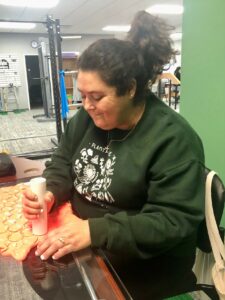
It would be a long road to recovery for Christina, but she had a support system she could count on. When her doctors asked about whether she wanted to go to an inpatient rehabilitation facility, Christina was quick with an answer. “I said, no, I want to go home. We had to add some railings and things to my house, and my husband was able to do that. My mom, who is a Nurse Practitioner, flew in from Florida and stayed with us for a month.” A decision had to be made quickly about where Christina should go for outpatient physical and occupational therapy. Beginning stroke rehabilitation right away can help ensure the best possible outcome. “I wanted a place where I could do both OT and PT, and I wanted it to be close to my house. We were calling places and they would say, ‘we do this, or we do that, but we don’t do both’. I was having to depend on someone to get me to therapy. I couldn’t depend on someone to get me to two separate places. So, that was the most important thing.”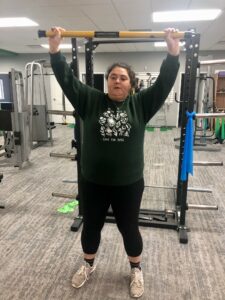
Christina discovered Advanced Physical Therapy Center, part of the Phoenix Physical Therapy family, offers physical AND occupational therapy. Christina chose the Fenton, Michigan clinic, which was close to her home. She began her therapy journey by walking through the doors at Advanced PT, using a walker. Stephanie Jarrett, PT, DPT and Renae Deshaw, OTRL evaluated her and immediately made her feel at home. “When I got there, they just said, ‘yes, you have these things going on, but we can help you.’” Stephanie and Renae talked to Christina about her long-term goals. She wanted to get back to work as a nurse in a prison, and she wanted to get back to her passion. “My husband and I have a small flower farm in Holly. We both work outside the home and it’s a thing we do together outside of work. Everyday I’m out there, it makes me feel like I’m getting back to my life again.” Renae knows it is important to make patients feel comfortable from the very beginning. “My philosophy is to try and give everyone as much information as possible. I want them to know everything I know to a level that they understand, so they feel good about it. We both asked about her goals. I think just bringing those things up in her first visit made her feel better.”
Christina’s first short-term goal was to walk without the walker. Many of the exercises she completed for the first few weeks, focused on achieving that milestone. “I started by walking, holding on to the bars. Then, they had me use an exercise bike. I remember they had to strap my leg in, in the beginning. And I remember when I moved from the bike to the treadmill, and I had the gait belt on. Stephanie said, ‘you are going to walk for seven minutes, and then you are going to rest and then we will do another 7 minutes’. And Ashley, (a PT student in training) held on to me and I did it!” Stephanie remembers how it took some time for Christina to get used to the idea that she would recover. “I feel like the more she gained confidence, she became more trusting of us. At first she was very nervous, but as she got stronger and saw how good she was doing with it, she felt better.”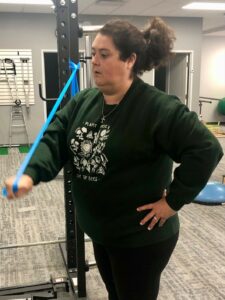
A month after her stroke, Christina graduated from using a walker to using a cane for the first time. The path to get there was not always smooth, however. “I remember when I was at the bars over by the mirror. I didn’t realize the mirror was there. I was trying to walk over the hurdles, and I caught sight of myself in the mirror. I thought, oh my gosh, this is my gait. And what I was trying to do wasn’t hard. I was trying to lift my leg 3 or 4 inches off the ground. I couldn’t believe how hard it was and I started crying.” Stephanie and Renae were right there to lift her back up with words of encouragement. Renae remembers that day too. “It is important to show her how far she’s come. She thought she was going backwards. She didn’t realize what she can do now that she couldn’t do before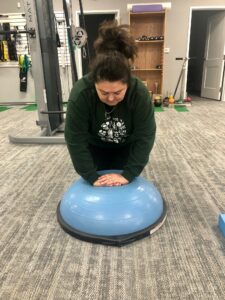 .” Christina took the advice of her therapists. “You need that encouragement. It’s hard to see the progress. I think once I moved from the walker to the cane, I thought, OK, we are getting there. That’s visible progress.”
.” Christina took the advice of her therapists. “You need that encouragement. It’s hard to see the progress. I think once I moved from the walker to the cane, I thought, OK, we are getting there. That’s visible progress.”
Stephanie and Renae followed Christina’s lead when it came to each therapy session. They listened to her concerns and altered their plans to focus on the milestones she wanted to reach. “What kept me coming here was they were letting me take change of my therapy. I have to do CPR at my job. I explained I have to do it on the floor, because of where I work. So, Stephanie and Renae talked with each other and decided to try the Bosu ball to mimic the action of CPR. I practiced getting up and down off the floor and added the compressions on the Bosu ball.” Christina is grateful she chose Advanced for her rehabilitation. She feels it is important for the patient and therapist to collaborate to achieve a successful outcome. “Sometimes people think if you go to occupational therapy or physical therapy, (the therapists) are going to somehow cure you. That’s not what happens. It’s a partnership and you have to be willing to put in the work and you need to have practitioners who are willing to help you reach your goals.”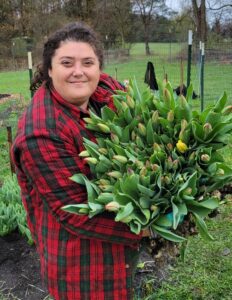
About four months after her stroke, Christina reached her rehabilitation goals with help from the team at Advanced PT-Fenton. She is back to work and is once again enjoying her flower farm with her husband. She has this advice for people who may be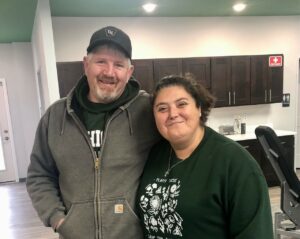 usure about what physical or occupational therapy can do for them. “It makes all the difference being able to get back to your life. It’s hard to come here and be vulnerable. But I’m so glad I kept coming. It has to do with the practitioners here. These guys are amazing. I feel like they’re part of my family now. I think when you are nurse, you are used to helping other people and not really in a position to receive help, and they have done that for me. I feel like they will be in my heart forever. It’s a life changing thing that happens to you and when you have people who want to see you succeed, it makes such a difference in your recovery and your confidence in yourself.”
usure about what physical or occupational therapy can do for them. “It makes all the difference being able to get back to your life. It’s hard to come here and be vulnerable. But I’m so glad I kept coming. It has to do with the practitioners here. These guys are amazing. I feel like they’re part of my family now. I think when you are nurse, you are used to helping other people and not really in a position to receive help, and they have done that for me. I feel like they will be in my heart forever. It’s a life changing thing that happens to you and when you have people who want to see you succeed, it makes such a difference in your recovery and your confidence in yourself.”
